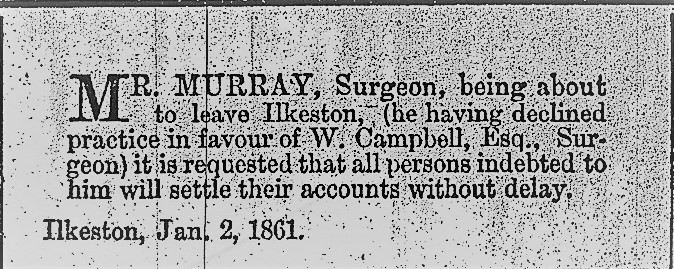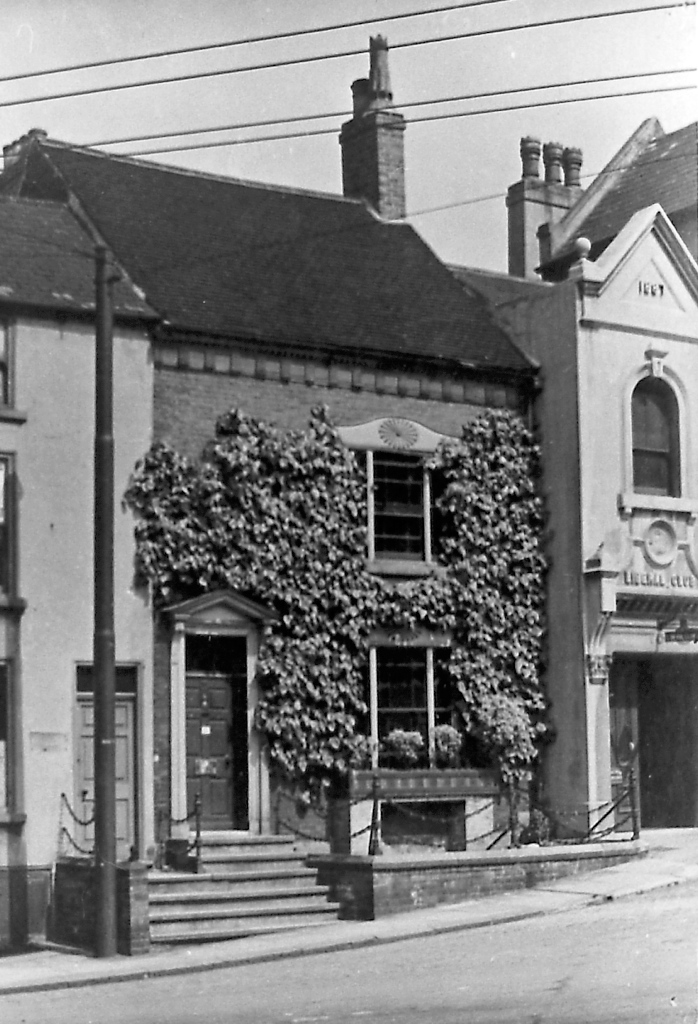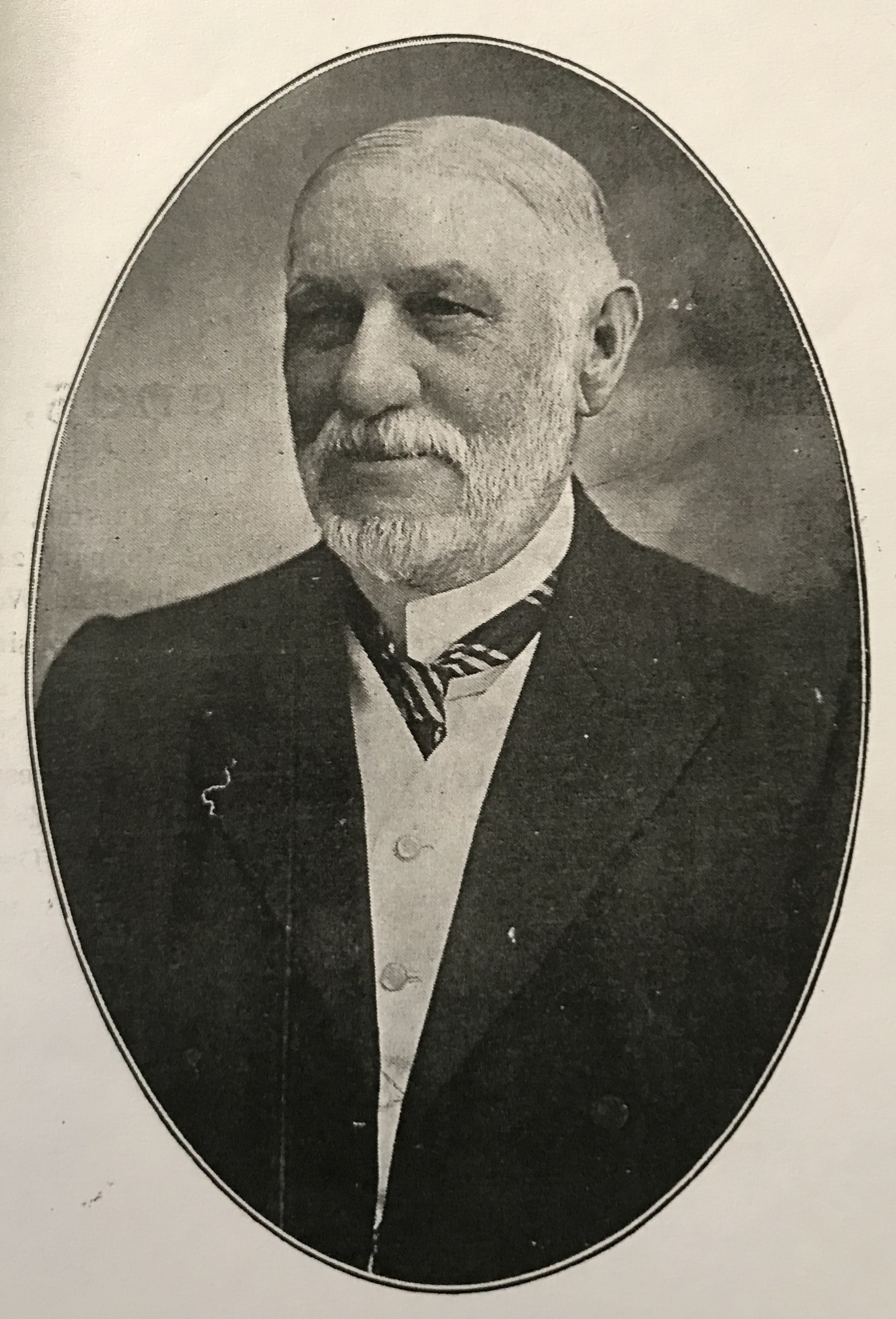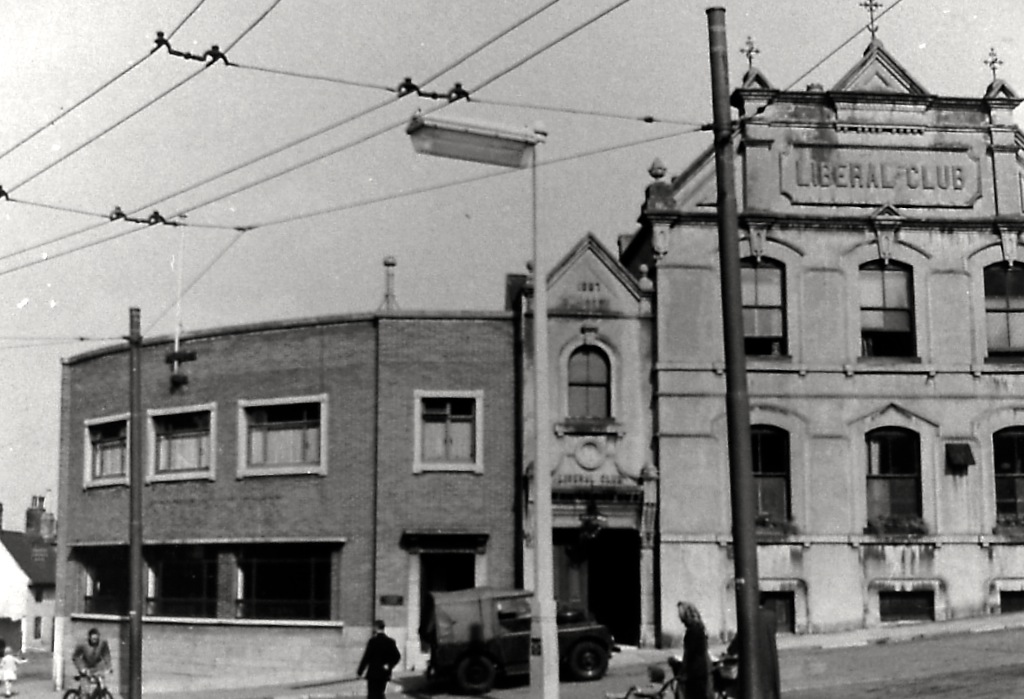Between Pat Pollard (on the left) and Matthew Hobson’s shop (on the right) was the Doctors’ House … that’s the one with the garden growing up its face. Notice that, at the time this photo was taken, both Pat and Matthew had long gone.
Adeline recalls that “Ilkeston, being a small town, two doctors were sufficient to look after the health and well-being of the inhabitants”. Yet at various times there were more than two. These are the Ilkeston doctors whom I have evidence for … so far… and in approximate chronological order.
——————————————————————————————————————————-
Surgeon George Blake Norman was a constant presence at Dalby House, (High Street or Anchor Row) throughout the period 1828-1870. He is recorded – with one inaccuracy– in all the trade directories and censuses of that period. From the late 1860’s he worked with his eldest son, George Alfred.
——————————————————————————————————————————-
William Parkinson is listed as surgeon in Pigot’s and Glover’s Directories of 1829 and in Pigot’s Directory 1835.
In 1810 he had married Mary James, sister of Thomas Roe James and Ann Dorothy Horsley (nee James) and whose family we shall meet briefly in Nottingham Road. (See On the east side).
Surgeon William died in 1837 and his wife in the following year. Both were buried at St. Mary’s Church.
——————————————————————————————————————————-
George Lucas came in to replace William and made himself known around town. At the end of 1839 he gave “a convincing and interesting lecture on the leading principles of phrenology” to the Ilkeston Artisans and Mechanics’ Institute, so interesting that he was persuaded to commit to an additional lecture. So George gave the same lecture when the Institute celebrated its anniversary on May 15th, 1840.
On the 1841 census John Turner, surgeon, is listed at the Market Place address and George Lucas , surgeon, is at Bath Street. At the end of the following year Dr Lucas was occupying a house in Mount Street owned by William Bell, framesmith and proprietor of the Travellers’ Rest beerhouse in White Lion Square. That freehold house, and its two neighbours in Mount Street, as well as the house occupied by Robert Wade in Club Row, were put up for auction in December 1842.
By June 1847 George was not feeling well at all. In fact he was so depressed about his own health that he returned to his native Scotland, convinced that his death was imminent. And his premonintion was proved accurate, as on September 12th he died at Clova, Forfarshire, aged 35, at peace in the country he loved. “He was held in general esteem in the town and neighbourhood of Ilkeston, for his uprightness, integrity, and professional skill, and was greatly respected by a large circle of friends”.
On July 17th 1848, at the annual meeting of the Manchester Order of Oddfellows held at the Wine Vaults, the memory of George Lucas, deeply lamented friend and brother, was celebrated.
——————————————————————————————————————————-
On the 1841 census surgeon Edgar Henry Longstaff is at West Gate in Worksop, Nottinghamshire, with his wife Cornelia Hamilton (nee Buchanan) and four-year old son Frederic Buchanan Longstaff.
By the summer of 1841 the Longstaff family had arrived in Ilkeston, and in 1842 Edgar Henry was appointed as Medical Officer for the Ilkeston district of the Basford Board of Guardians at a salary of £25 pa. The post had become vacant on the resignation of John Turner. He had then been in practice for eight years.
Pigot’s Directory of 1842 shows the presence in Ilkeston of surgeons James Robb and Edgar Henry Longstaff.
In 1843 Edgar Henry was re-appointed as Medical Officer for the Ilkeston district of the Basford Board of Guardians at a salary of £35 pa. On August 30th of 1843, Helen Neill Longstaff was added to the family.
In 1846 Edgar Henry was lodged in the Market Place where he lived with his wife Cornelia though their son Frederic Buchanan Longstaff was not then with them.
In April 1844 eight-year old Frederic Buchanan was playing in St. Mary’s churchyard, at a time when repairs were being carried out on the church’s chancel. Labourer William Burrows was up his ladder, throwing down stones from an outside wall, seemingly taking great care as he threw down each stone. Unfortunately he did not see the young lad who suddenly appeared from behind a buttress, just as William had released a stone weighing more than half a hundredweight. The boy was killed instantly.
A sign of ‘things to come’ ? In April 1848 Edgar Henry appeared at Nottingham County Court where he was ordered to pay a debt of 17s 6d.
Edgar Henry was in Ilkeston until at least September 1850 when he appears to have auctioned off his furniture and other belongings prior to leaving the town for ‘the South of England’. At his Market Place address, prospective purchasers were offered “lofty 4-post, French and tent bedsteads, with every requisite for five bed-cambers, set of six and two arm mahogany chairs, in hair seating; Spanish mahogany extending dining tables, bagatelle board, square piano forte, by Tomkinson; music stool, Canterbury, Brussels floor carpets; set of six imitation rosewood chairs, in blue damask; couch, two easy chairs in morocco, mahogany work table, ditto on pillar and claws; a good assortment of culinary articles; rich cut glass, surgery fixtures, and other items”.
There was also an extensive and valuable book collection and nearly-new lamps; a phaeton, with drab cushions, a six-year old chestnut pony and a yearling filly, harnesses, saddles and bridles; garden tools, cucumber frames, a variety of bee-hives, bee-hive sheds and all accoutrements …. and a pig.
Edgar Henry moved to Folkstone, Kent, thence to Boulogne, France, on to 12 Russell Street, Chelsea (by now out of practice), then to 134 Rotherhithe Street, Rotherhithe, to Underdown Road, Herne Bay, and finally at High Street, Camden Town (out of practice) — all by mid-1853. And now in serious financial difficulties.
In August 1853, then a ‘prisoner’, he was called before the court as an Insolvent Debtor. It appears that at this time he was also known as ‘Edgar Henry Monckton’.
The doctor eventually settled in Hammersmith where he died in 1862 while his widow died there ten years later.
——————————————————————————————————————————-
Adeline’s own family doctor was “Dr. Murray who lived in the house in the Market Place that was afterwards occupied by the late Dr. Wood. Dr. Murray brought my sister and myself into the world, and I have in my possession the receipt for professional services that he gave to my parents at my birth. “
Robert Murray appears in Slater’s Directory of 1850 and on the 1851 census at Bath Street.
In April 1853 he moved from Bath Street to the Market Place house previously occupied by Edgar Henry Longstaff, and is recorded in Directories 1855-1860 as ‘surgeon of Market Place’.
“Dr. Murray was unfortunately drowned when returning from Ireland, where he had been on holiday. This was 1858 or 9″.
Adeline’s memory seems to be playing tricks here. Dr. Robert Murray is listed on the 1861 census as a lodger with Thomas Severn, joiner of the Cottage, High Street.
 from the Ilkeston Leader of January 3rd 1861
from the Ilkeston Leader of January 3rd 1861
The census shows him to be a Member of the Royal College of Surgeons (M.R.C.S.), Edinburgh, Licentiate of the Royal College of Surgeons (L.R.C.S.), Edinburgh, and General Practitioner. This was on March 30th of that year and he was still there on April 25th when he took out an advert in the first issue of the Ilkeston Leader to announce that he was leaving the town in a short time. He was asking past patients to settle their bills with him or he would ‘institute legal proceedings against them‘. (a similar one to that shown above … perhaps his patients were very slow to pay their debts !!)
On account of his ill-health Dr. Murray left Ilkeston later in 1861 to return to his native Edinburgh and died at 9 Howe Street, on August 16th 1863.
Another lodger at the same address in 1861 is Dr Nathaniel Best Gill. (*see below)
Old Resident believes that when he (that is, Old Resident) came to Ilkeston in 1858 Dr. Murray had been succeeded by Dr. William Campbell, who in turn was succeeded by Dr. William Date, all three of them living in the ‘Doctor’s House’ in the Market Place.
——————————————————————————————————————————-
Dr. William Campbell, Fellow of the Royal College of Surgeons (Edinburgh), came to Ilkeston in the late 1850s living at the house previously occupied by Dr. Murray (later Dr Wood’s house) and eventually taking over his practice.
William Campbell is at the Market Place in 1861 and received his degree of Doctor of Medicine from the University of St. Andrew’s, Edinburgh, in May 1862.
——————————————————————————————————————————-
There was also Dr. William Date at the same address and in the same practice. In September 1864 William married Mary Horton, eldest daughter of Birmingham surgeon Joseph John Horton and Mary (nee Day), at Aston Church in that city and came to Ilkeston about that time.
In 1866 the doctor fancied adding to his ‘wardrobe’ and approached tailor Thomas Henry Booth of Ilkeston Common to make for him a couple of waistcoats and a pair of trousers, at an agreed price of £2 5s. The clothes were made and delivered but when it came to payment, William wanted to deduct the amount from a bill which Thomas Henry owed to the doctor for his past services.
‘Not on your life !!‘ was the tailor’s reply … he wanted the money.
The doctor wouldn’t pay.
Where else to solve the dispute but at Belper County Court ?!
As no mention had been made of setting one bill against the other at the time of the order for the clothes, the judge decided that the doctor had to pay up !!
In 1868 William and his family left the town for Crewkerne in Somerset and he died there in 1874, aged 35.
Born in Ilkeston in 1866, their son William Horton Date returned to Elmhurst in Ilkeston, having passed the exams to enter the Royal College of Surgeons (England) in 1888, and the 1891 census shows him as a General Practitioner working with GP Harry Potter in Bath Street. On September 14th, 1893, while practicing at Culmstock, Devon, he married Margaret Adlington, daughter of the late William Sampson Adlington, at Holy Trinity Church in Ilkeston.
——————————————————————————————————————————-
In 1858 Dr. Wallis was residing at Bath Hotel Villa. He took over from Dr. Ralph Coulson when the latter, who was visiting the private mental hospital at Wyke House, Isleworth, died in October 1860.
——————————————————————————————————————————-
Arriving in Ilkeston in the late 1850s was James William Eaton who appears at Bath Street in the Harrison, Harrod & Co. Trade Directory of 1860. Born in 1835 at Marston upon Dove, the son of William and Harriet (nee Oliver), James William was educated and qualified, M.R.C.S., at Middlesex Hospital in London about 1857. He then practised for a little under a year as a medical assistant in Kendal before settling at Ilkeston.
Ilkeston Pioneer Sept. 15th 1859
Dr. Eaton appears on the 1861 census at Bath Street with his wife Mary Dorothy (nee Foster), daughter of John and Mary Ann (nee White). At the end of 1861 he was admitted a Licentiate of the Royal College of Physicians of London. He left the town a few months later to live and practise in his wife’s home town of Bingham, Nottinghamshire.
——————————————————————————————————————————-
“Dr. Gill succeeded Dr. Murray, but not being strong, soon retired, and took rooms at Mrs. Thomas Severn’s, in the Gardens below High Street. He was a genial little man, but was handicapped by poor health.
He died later of consumption”.
As we have seen (*), Dr. Nathaniel Best Gill appears on the 1861 census lodging at the High Street house of Thomas Potter Severn. He had been in the town, as assistant to George Black Norman, at least from the first moths as 1857 — he had assisted in treating the injured at the Shipley Colliery Disaster of March 4th of that year.
By 1870 he was at Wilton Place. (J.G.Harrod & Co Directory).
He died at Dover in September 1870, aged 49.
——————————————————————————————————————————-
A contemporary of Dr. Date was Richard Lewis Davis M.D. who was working in the town in 1866.
Stone miner Henry Ironmonger (and brother of Nahum of Derby Road) married Caroline Elizabeth York, daughter of Joseph and Ann of South Street, at the Queen Street Baptist Chapel in 1866 and three months later their son William was born. Two months later and William was dead.
And this is where the problems for Dr. Davis began.
Three days after the death the coroner wrote to Edward Brady, Ilkeston’s inspector of police, suggesting the possibility of an inquest on the body of the child and a post mortem examination, though he also mentioned that such a process might be avoided. Armed with the letter and accompanied by Dr. William Date, the inspector attended the Ironmonger’s home in Park Road where the two visitors seemed to want to conduct an examination of the body, there and then.
The parents of the child were having none of it !! … and the father sent for Dr. Davis, who was their doctor, for support.
When the latter arrived he vehemently and passionately opposed a post mortem examination — he would not allow it. To reinforce his point there were suggestions that he became very physical, ‘attacked’ the inspector and swore at his medical colleague. And this conduct landed the doctor in court a couple of weeks later, charged by Inspector Brady with assault.
Thus , at the Petty Sessions, Dr. Davis was found guilty of a minor though not violent assault, and was fined £1 with 10s 6d costs.
* At the inquest William Ironmonger was found to have died from ‘convulsions’.
——————————————————————————————————————————-
Robert Wood was born in Uttoxeter, Staffordshire on January 6th, 1844, the son of Charles, maltster and keeper of the Cross Keys Inn in High Street, Uttoxeter and Sarah (nee Charlesworth). His mother had previously been married to Thomas Bunting, spirit merchant also of High Street, who had died in 1841 leaving Sarah with several Bunting children.
Robert came to Ilkeston in the later 1860’s to take over the practice of Dr. Date in 1868. And in that same year he became surgeon to the Duke of Rutland Lodge.
He married Elizabeth Ann Ball, youngest child of William and Susannah (nee Bennett) in 1872.
In the same year, in response to an outbreak of smallpox in the district, he was temporarily appointed as Medical Officer of Health to the Local Board, a position he assumed permanently the following year — though his position had to be renewed annually. By that time the town was free of smallpox.
Two years later the Board attempted to reduce Dr. Wood’s salary from £30 per annum to £20. The good doctor politely declined the appointment on these terms and the Board promptly restored the original salary level.
In April 1879 Robert was called to attend on eight-year-old Mark Beardsley of Norman Street (aka Grass Lane), son of blind grocer Isaac and Julia (nee Davis). Never a strong child, in the last few days Mark had suffered from excessive vomiting, violent pains in, and constipation of, the bowels, and had developed a dark hue about the skin of his body. Mother Julia had given him a little sweet nitre and marsh mallows, and poulticed him all day on Tuesday. When the pain got worse Dr. Wood was called in.
On entering the lad’s bedroom which he shared with two older brothers, the doctor noticed a smell of paint and was told by the mother that the room had indeed been newly painted. Mark had slept in it every night since the work was done nearly a month before. Medicine was prescribed but on the following day the lad died. The doctor was of the opinion that death was due to lead poisoning or painter’s cholic, caused by sleeping in a newly painted room, and this was the verdict reached at the subsequent inquest.
In the summer of 1883, through pressure of work, Robert resigned as the Local Board’s Medical Officer of Health.
In 1972 Nelson Bestwick, newsagent of the Market Place, recalled seeing Dr. Wood when he was a young lad in the early twentieth century (Nelson was born in 1908)….. “Ridden horses were very rarely seen on the streets of Ilkeston, but Dr. Wood was a familiar figure, setting out on his country rounds upon a chestnut pony and attired in bowler hat, riding coat, breeches and leggings, with his bag fastened to the saddle. I saw him for the last time when his pony slipped on the smooth tarmac in front of Tasker’s shop (a draper in the Market Place); he fell and I believe broke his arm and shoulder, the kindly old man dying shortly afterwards”.
——————————————————————————————————————————-
Charles Alfred Cooper of Bonsall Place was appointed to replace Robert Wood.
Just over a year later — in November 1884 — Charles Alfred died, aged 33, and Dr. Walker provisionally took the position until Dr. Joseph Carroll was permanently appointed in January of the following year.
——————————————————————————————————————————-
For information on the Ilkeston doctors at the turn of the century, see Dr. Brigham
——————————————————————————————————————————-
You can compare this photo with the one at the top, and see exactly where the Doctor’s House would have been. (The distinctive facade of the Liberal Club can be spotted in both)
——————————————————————————————————————————-
And before we arrive at Anchor Row (again) we pass the premises of Matthew Hobson.





